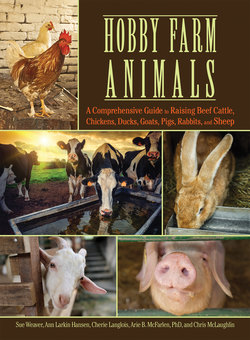Читать книгу Hobby Farm Animals - Chris McLaughlin - Страница 34
На сайте Литреса книга снята с продажи.
Selling at Auction
ОглавлениеSending animals to an auction barn for sale is probably the most common way for small producers to market their beef cattle. An estimated 85 percent of beef cattle in the United States are sold through a local auction barn at some point in their lives. These barns hold regular auctions for a variety of different ages and weights of animals, from special fall feeder-calf auctions to weekly auctions of fat cattle and cull cows.
To find the auction barns in your region, check your area farm paper, ask the neighbors, or call your extension agent. If you’re fortunate enough to have a choice of two or three different barns, find out which type of cattle each barn specializes in, and keep an eye on their sale prices. You don’t want to send a load of beef feeder calves to a barn specializing in dairy cattle because the buyers obviously won’t be too interested in beef calves. If they were, they’d be at the auction barn having the feeder-calf sale. Somebody at a dairy barn will probably buy your feeder calves, but they won’t have to bid nearly as high to get them, which means that you, the owner, lose money.
Once you’ve decided on an auction barn, call to get more information and instructions for selling your cattle there. Many auction barns have field representatives who will talk to you over the phone or even visit your farm to discuss the best time to sell cattle and how to prepare and transport them to obtain the best price. Ask if you should have the cattle there the day of the auction or the night before. Find out what the availability and charges are for penning, feeding, and watering your cattle before the sale.
Most types of beef cattle don’t require any special preparation before an auction, except to make sure they are well watered and fed and are loaded calmly onto the truck. Feeder calves do require some special measures to obtain a top price. Buyers are especially interested in uniform groups of calves that will grow and finish at the same rate. Usually, buyers will pay a bit more for calves that are already vaccinated and weaned, have been started on a grain ration (also called bunker broke), and have been knife-castrated.
This is a very important point, so I’m going to repeat it: calves that are to be sold as feeders in the fall, whether directly to a feedlot or at auction, should have been weaned for a minimum of three weeks, should know how to eat grain from a bunker feeder, and should have been knife-castrated. They also should have been vaccinated in the neck and boostered two to four weeks later, again in the neck. Heifers that are to be sold as breeding stock should have their brucellosis vaccinations.
Some auction barns have programs in which the cattle owner or the owner’s veterinarian signs a document stating that these procedures have been done. This will be mentioned during the auction and usually affects the sale price. Yet it’s not all about money. When you’ve preconditioned your calves, you know that their sale and move to a new home will be much easier on them. Calves that are preconditioned have lower rates of illness and death compared with calves that are not. The former are less stressed and are more likely to settle into their new homes quickly and to gain weight rapidly. Those calves build your reputation among buyers.
